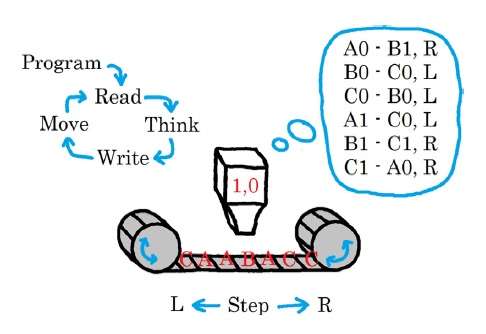March 28, 2013 feature
Artificial muscle computer performs as a universal Turing machine

(Phys.org) —In 1936, Alan Turing showed that all computers are simply manifestations of an underlying logical architecture, no matter what materials they're made of. Although most of the computer's we're familiar with are made of silicon semiconductors, other computers have been made of DNA, light, legos, paper, and many other unconventional materials.
Now in a new study, scientists have built a computer made of artificial muscles that are themselves made of electroactive polymers. The artificial muscle computer is an example of the simplest known universal Turing machine, and as such it is capable of solving any computable problem given sufficient time and memory. By showing that artificial muscles can "think," the study paves the way for the development of smart, lifelike prostheses and soft robots that can conform to changing environments.
The authors, Benjamin Marc O'Brien and Iain Alexander Anderson at the University of Auckland in New Zealand, have published their study on the artificial muscle computer in a recent issue of Applied Physics Letters.
"To the best of our knowledge, this is the first time a computer has been built out of artificial muscles," O'Brien told Phys.org. "What makes it exciting is that the technology can be directly and intimately embedded into artificial muscle devices, giving them lifelike reflexes. Even though our computer has hard bits, the technology is fundamentally soft and stretchy, something that traditional methods of computation struggle with."
The artificial muscle computer is modeled on Stephen Wolfram's "2, 3" Turing machine architecture, which is the simplest known universal Turing machine. It consists of a machine head that reads symbols stored on a tape, and then based on the symbols and its own state (0 or 1), it follows a set of instructions that tells it what to write and store. The 2, 3 Turing machine is ideal to build with artificial muscles because of its simplicity. The researchers could theoretically solve any computational problem using just 13 muscles.
By expanding and contracting, the artificial muscles performed a variety of mechanisms involved in the computing process. For example, the muscles pushed sliding elements into position, and the sliding elements were used to encode data. Artificial muscles were also used to make the instruction set that the machine head uses to make decisions. In this case, when a muscle expands, it compresses a switch, causing it to conduct charge.
In its current version, the artificial muscle computer is very large (about 1 m3) and extremely slow (0.15 Hz). However, the researchers demonstrated that it could evolve the correct sequence of calculations in response to a test input, and they predict that the computer's performance could be significantly improved. In the future, the researchers also want to investigate whether this type of computer would perform better using an analog rather than digital architecture.

Overall, the demonstration that artificial muscles can be made to compute and "think" has implications for future prosthetics and soft robots. By sensing, computing, and moving, artificial muscles could give these devices the ability to conform to complex and uncertain environments, as well as give them reflexes like the real muscles seen in nature.
"If you look at life you see these amazing capabilities and structures," O'Brien said. "The octopus, for example, has extremely dexterous infinite-degree-of-freedom manipulators. Such manipulators would be great for our own robots, but there is the huge challenge of how to control them—the degrees of freedom can overwhelm a central controller. Octopuses solve this by distributing neurons throughout their arms. With artificial muscle logic, we might one day be able to do the same."
The researchers plan to take several steps in order to reach these goals.
"In the future we would like to miniaturize the technology to make it go faster and become more portable; develop materials that last longer before failing; make the computer entirely soft; explore analogue architectures; and build a soft robotic manipulator with a built-in computer," O'Brien said.
The researchers have also recently formed a company called Stretch Sense that makes soft wireless stretch sensors using artificial muscle technology. In the future, they hope to commercialize their artificial muscle computing as well.
More information: Benjamin Marc O'Brien and Iain Alexander Anderson. "An artificial muscle computer." Applied Physics Letters 102, 104102 (2013). DOI: 10.1063/1.4793648
Journal information: Applied Physics Letters
Copyright 2013 Phys.org
All rights reserved. This material may not be published, broadcast, rewritten or redistributed in whole or part without the express written permission of Phys.org.
















